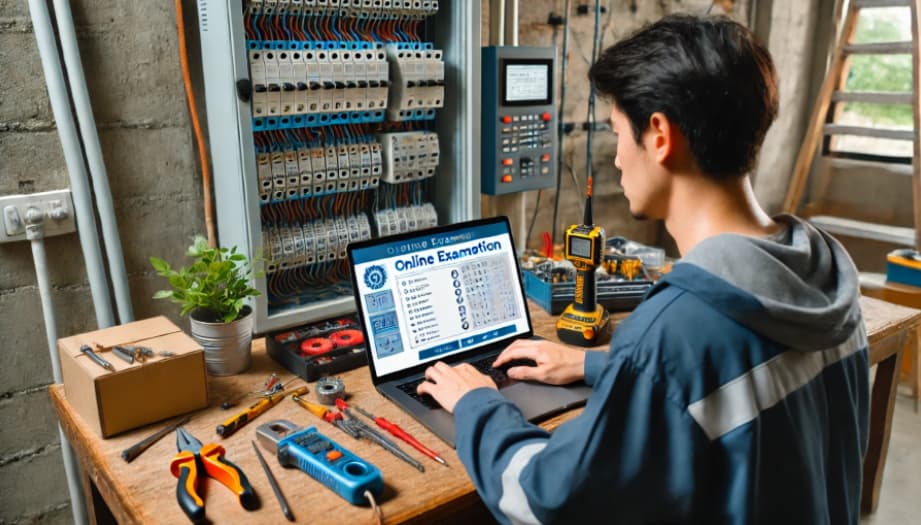If you’re looking to break into a career in construction, maintenance, or skilled trades within the utility industry, chances are you’ve encountered the CAST test—short for the Construction and Skilled Trades Selection System.
This standardized exam is used by many utility companies across North America to identify candidates who have the potential to excel in physically demanding and technically precise roles.
Conquer the CAST Test

Developed by the Edison Electric Institute, the CAST test is designed to assess a candidate’s aptitude for jobs in the construction and skilled trades sectors—particularly within electric, gas, and water utilities. Roles may include:
- Electrical Technician
- Lineworker
- Plant operator
- Equipment operator
- Maintenance Mechanic
- Field service technician
Utility companies rely on the CAST test because it evaluates the core skills needed for these roles: problem-solving, attention to detail, mechanical reasoning, and graphical understanding.
Why the CAST Test Matters?
The CAST test serves as a screening tool that helps employers ensure new hires are prepared for the technical and physical demands of utility jobs. These jobs often involve:
- Operating complex equipment
- Interpreting technical diagrams
- Performing calculations under pressure
- Solving practical mechanical problems
Utility companies can’t afford to take risks with unprepared employees. That’s why the CAST is a gatekeeper in the hiring process. If you want to land the job, passing the CAST is non-negotiable.
Who Takes the CAST Test?
The CAST exam is usually taken by applicants pursuing entry-level or apprenticeship positions in the skilled trades.
Whether you’re a recent high school graduate, a military veteran transitioning into civilian employment, or a career changer looking for more stability, the CAST is often your first step.
It’s also a requirement for applicants in both union and non-union settings, depending on the utility company’s policies.
In most cases, the test is administered after an initial job application and before an interview.
Preparing for the CAST Test
- Understand the Exam Format
Start by familiarizing yourself with the structure of the test. Knowing how each section is timed and what types of problems appear will help reduce anxiety and improve your test-day confidence.
- Identify Your Weak Points
Not everyone comes into the CAST test with equal skills. For example, you may be strong in mechanical reasoning but struggle with math. Focus your prep efforts on the areas where you need the most improvement.
- Use Study Guides and Workbooks
There are several prep books and online resources tailored to the CAST test. Look for guides that break down test topics and offer step-by-step instructions. A quality resource will also explain test logic, common traps, and answer explanations.
- Take a free cast practice test
One of the best ways to simulate the exam experience is by completing a free cast practice test. These practice tools can help you:
- Get used to the format and timing
- Identify knowledge gaps
- Build test-taking endurance
- Reduce test anxiety
While practice doesn’t guarantee a perfect score, it can drastically improve your ability to navigate the test with speed and accuracy.
Benefits of a Free CAST Practice Test
Here’s why using a free cast practice test is one of the smartest moves you can make:
- Cost-Effective: You get access to test simulations without needing to invest in expensive prep materials.
- Realistic Experience: Mimics the structure and pressure of the actual exam, so you know what to expect.
- Immediate Feedback: Helps you analyze what you got wrong—and why—so you can improve.
- Custom Study Plan: Guides your study efforts more effectively by pinpointing strengths and weaknesses.
Even if you have a strong background in trades or mechanical systems, a practice test gives you the edge by helping you think like the test creator.
Common Challenges and How to Overcome Them
- Time Pressure
Many candidates report feeling rushed, especially in the math and reading sections. The solution? Take timed practice tests and train yourself to move quickly and efficiently.
- Technical Diagrams
If you’re not used to interpreting schematics or blueprints, the graphic arithmetic section can be tough. Spend time reviewing visual data and how it translates into numerical problems.
- Mental Fatigue
A long test with multiple sections can lead to burnout. Build stamina by studying in blocks and taking full-length practice exams using a free cast practice test.
Tips for Success
- Study regularly: Don’t cram. Spread your prep out over several weeks.
- Review basic math and physics concepts: Especially units, fractions, force, and motion.
- Practice reading technical passages: These will show up in the comprehension section.
- Focus on diagrams and spatial awareness: The test favors visual thinkers.
- Get comfortable with test timing: Practice working under pressure.
And remember—confidence is key. The more familiar you are with the format, the more likely you’ll approach the test with calm and clarity.
Final Thoughts: Invest in Your Future
Scoring well on the CAST test can be the gateway to a secure, hands-on, and well-paying career in the skilled trades.
It’s not a test to take lightly, but it is one you can prepare for—regardless of your background.
By understanding the test format, identifying your knowledge gaps, and using tools like a free cast practice test, you can walk into the testing center with confidence and walk out one step closer to your dream job.



